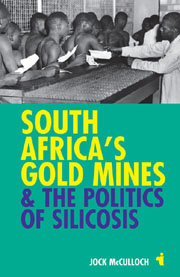Book contents
- Frontmatter
- Contents
- List of Photographs
- Preface: South Africa in the Twentieth Century
- Acknowledgments
- List of Abbreviations
- A Brief Chronology
- 1 Gold Mining & Life-Threatening Disease
- 2 Creating a Medical System
- 3 Compensation
- 4 A White Science
- 5 Myth Making & the 1930 Silicosis Conference
- 6 Tuberculosis & Tropical Labour
- 7 Conflict over the Compensation System
- 8 Healing Miners
- 9 The Sick Shall Work
- 10 Men Without Qualities
- Select Bibliography
- Index
2 - Creating a Medical System
Published online by Cambridge University Press: 05 February 2013
- Frontmatter
- Contents
- List of Photographs
- Preface: South Africa in the Twentieth Century
- Acknowledgments
- List of Abbreviations
- A Brief Chronology
- 1 Gold Mining & Life-Threatening Disease
- 2 Creating a Medical System
- 3 Compensation
- 4 A White Science
- 5 Myth Making & the 1930 Silicosis Conference
- 6 Tuberculosis & Tropical Labour
- 7 Conflict over the Compensation System
- 8 Healing Miners
- 9 The Sick Shall Work
- 10 Men Without Qualities
- Select Bibliography
- Index
Summary
In May 1901 the gold mines, which had been closed during the South African War, reopened. Many of the Cornish miners who had left for Britain at the beginning of the war had never returned and, according to the government mining engineer for the Transvaal, in the interim more than two hundred former rock drillers had died of silicosis. The report created adverse publicity in the British press and questions were asked in the House of Commons. In February 1902 a British parliamentary delegation visited South Africa to investigate the incidence of silicosis and one MP, Gilbert Parker, wrote to the Chamber of Mines, ‘I am convinced that the importation of natives from the Zambezi valley and from Central Africa ought to be stopped, the percentage of deaths amongst the natives on mines [from pneumonia] being seriously high chiefly because of the mortality amongst these particular natives.’ In response, the commissioner for native affairs, Godfrey Lagden, met with the Chamber to discuss what was clearly a health crisis. A committee was appointed that included Drs L. G. Irvine, D. MacAuley and Andrew Watt.
The committee report identified a serious problem with the mortality rate at 54.5 per 1,000. It noted: ‘Native workers are particularly susceptible to this disease [pneumonia] and the conditions of mining work favour its incidence.’ Pneumonia was caused by a combination of fatigue, crowded compounds, poor nutrition, and inadequate clothing.
- Type
- Chapter
- Information
- South Africa's Gold Mines and the Politics of Silicosis , pp. 14 - 32Publisher: Boydell & BrewerPrint publication year: 2012



